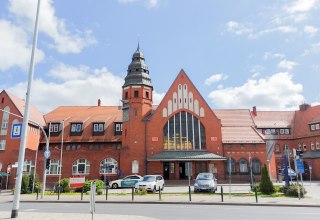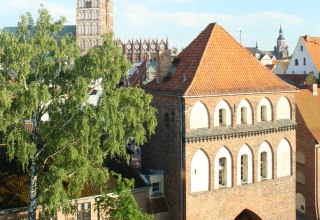Stralsund's St. Jacob's Church was first mentioned in a document in 1303. The church, which was under construction at that time, is thus the youngest of the three parish churches in the Hanseatic City of Stralsund. The differently glazed molded stones and the ornamental wealth of blinds and friezes make the basilica stand out clearly from the other Sundian churches.
St. Jacob's Church was built on the former dividing line between Stralsund's Old and New Towns. In the middle of the 14th century, the nave was raised in the original hall church, the side aisles were extended by chapels and the new west tower was erected. With the 68-meter-high tower, the choirless church received its most beautiful architectural part.
In the course of history, St. Jacob's Church has suffered many wounds. Of the three parish churches in Stralsund, it suffered the most: in 1628 it was hit by thirty bullets during Wallenstein's siege. In 1662 the Gothic tower pyramid burned down by lightning. The baroque tower dome was built in 1678. Artillery fire caused considerable damage to the interior of the church in 1678 and 1715. At the beginning of the 19th century the French used it as a horse stable. St. Jakobi was also not spared during an air raid on October 6, 1944. The magnificent pulpit by the Stralsund sculptor Hans Lucht and the oil painting by Johann Heinrich Tischbein with the motifs "Deposition from the Cross" and "Assumption" were saved. In 1955, the Gustav Adolf Hall was built in the gallery area of the tower. With the help of federal and state subsidies as well as the German Foundation for the Protection of Monuments, St. Jacob's Church was restored.
Today, St. Jacobi's Church no longer hosts church services - as a city and cultural church, it has become a special location for events such as theater performances, exhibitions and concerts.
Since 2020, the new old Jakobi organ has also been in use. The instrument had been unplayable since it was plundered at the end of World War 2. For three years it was rebuilt in traditional 18th century craftsmanship: A new Wegscheider organ was installed in the historic baroque organ case from 1741 - a new historic instrument in its old historic dress, so to speak. The sound style of the 18th century was chosen for the new organ. This style embodies powerful fullness and colorfulness. Inspired by the style of Gottfried Silbermann and Joachim Wagner, the organ is celebrated as the first great "Bach organ" in MV. At the same time, it is the largest new organ built in Mecklenburg-Vorpommern to date and guarantees versatile concert use, for example in combination with soloists, choirs and orchestras.


























